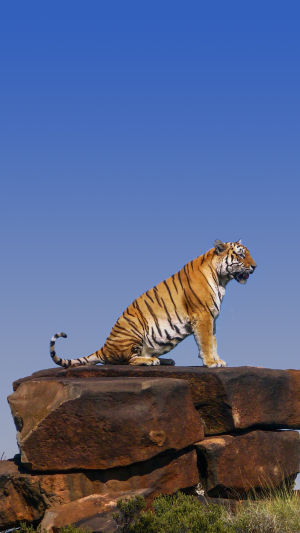The tiger (scientific name: Panthera tigris) is a large mammalian feline. The tiger is one of the largest felines in the world, typically ranging from 4-7 feet in length and 140-660 pounds in weight.
It has an orange-to-reddish coat with black stripes and a white underbelly. It has a distinctive facial pattern with pointed ears, round eyes, and a muzzle.
The coat is light yellow or brownish yellow. The head is round and the ears are short, the back of the ears is black. There is a central white spot that is very prominent. The limbs are strong, and the tail is long and thick.
With a black ring pattern, the tail end is black. There are nine subspecies. The size and morphology of each subspecies vary greatly. The Siberian tiger is the largest. Males can reach 3.7 meters in length and weigh 423 kg.
The Sumatran tiger is the smallest living subspecies. The male tiger is 2.34 m long and weighs 136 kg.
The tiger is a typical montane forest dweller. From tropical rainforests and broad-leaved evergreen forests in the south. It can live well in deciduous broad-leaved forests and mixed coniferous forests in the north. Tigers are often solitary.
Only during the breeding season do males and females live together. No fixed nesting sites. They roam around in the forests and mountains in search of food and can swim. Tigers are active at dusk and rest in the daytime. If not disturbed, they rarely come out.
The mating season is usually from November to February. During estrus, the tiger's call is particularly loud. It can reach up to 2 kilometres away. The gestation period is about 105 days, with 1-5 cubs per litter. Usually 2 cubs, the newborn tiger cub weighs about 1 kg.
The lactation period is 5-6 months and the female tiger and cubs live together for 2-3 years. During this period, female tigers do not come into heat and mate. Therefore, under natural conditions, female tigers can only reproduce once every 2-3 years. Female tigers are sexually mature at the age of 3, while males are more advanced. The life span of a tiger is generally 20-25 years.
Therefore, to figure out the origin of tigers. It is necessary to rely on cranial fossils, especially dental fossils. According to Qiu Zhanxiang (1998), among the fossils that have been found in China, the earliest dated tiger fossil is probably the ancient Chinese tiger.
This species was built by the Swedish palaeontologist Zdansky in 1924. The specimen is a relatively well-preserved skull belonging to the same individual, the lower dental bed, and an atlas vertebra.
The fossil was discovered by the Swedish geologist Anderson, who was working as a mining consultant for the Chinese government at the time, at locality 38 in Henan Province, a locality whose exact geological age is unknown.
The Northeast tiger was once one of the largest tigers in terms of size, with large individuals reaching up to 300 kg. However, 1970 was a watershed year, and since then the size of the tiger has not been as large as it was before due to a decrease in prey and inbreeding.
Furthermore, due to the small number of Northeast tigers and the wide territory area, the competition between similar species is relatively less intense, leading to less infighting among them.
Nevertheless, the Northeast tiger is a very good external fighter, with its prey even including brown bears, black bears, and other large beasts, potentially ranking first in external combat, though it may be slightly inferior to the Bengal tiger in terms of its kind.
The name of the Indo-Chinese tiger is very misleading, as it looks like a tiger that lives mainly in India, but in fact, there is only one tiger in India, the Bengal Tiger.
The Indo-Chinese tiger is mainly found in Thailand, Laos, Vietnam, and other Southeast Asian countries. There are also a small number of them on the southwest border of China. Compared with the first two species of tigers, the Indo-Chinese tiger has a smaller body size.
The skull is also smaller.
The male tiger weighs 150-195 kg when it reaches adulthood. The female tiger is even smaller, weighing 100-130 kg, so the Indo-Chinese tiger ranks behind the Bengal tiger and the Northeast tiger in terms of combat power.
The South China tiger was once the most widespread and abundant in the world.
Its name is also confusing and looks like a speciality of South China. But in reality, its range occupies most of China. From North China to Southwest China, from East China to Central China, and even in areas such as Jinan, it has a large distribution.





